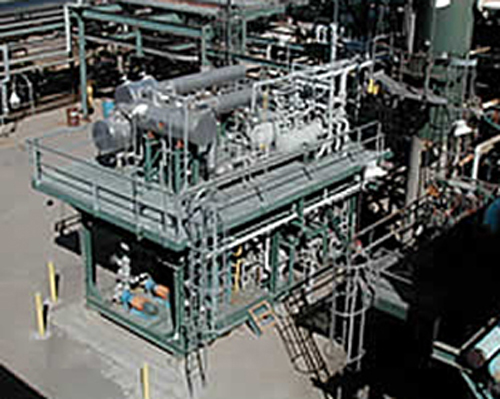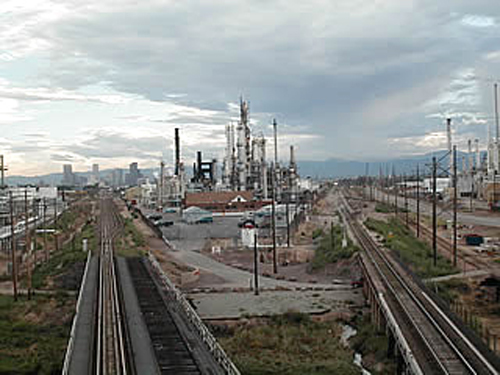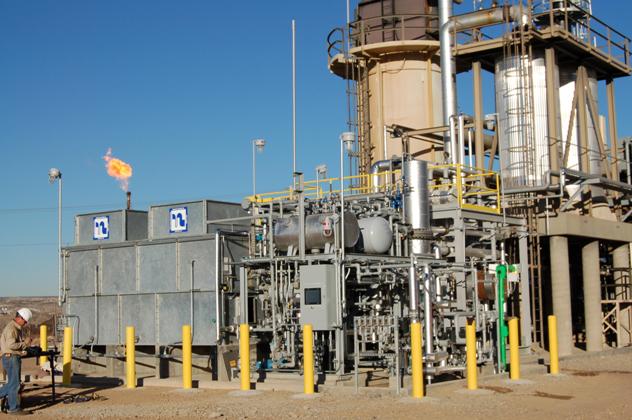- Home
- About Us
- Absorption Process
- Applications
- Publications, Technical Papers, News Releases
- Patent Estate
- Case Studies
- Energy Links
- Contact Us
(410) 266-6521
Get Our News
Sign up below to subscribe to our news
Refinery Chilling
Ammonia Absorption Refrigeration Unit Provides Environmentally Friendly Profits for an Oil Refinery
 The 27,000 barrel-per-day Denver refinery of Ultramar Diamond Shamrock (UDS) suffered from low profitability and low energy efficiency. One indicator of these problems was the large flare that burned almost continuously.
The 27,000 barrel-per-day Denver refinery of Ultramar Diamond Shamrock (UDS) suffered from low profitability and low energy efficiency. One indicator of these problems was the large flare that burned almost continuously.
Many refineries, like the UDS refinery, have waste gases that are routed to a fuel header. When the amount of waste gas exceeds the requirements of the refinery furnaces and boilers, the excess is flared. A small fraction of the waste gas is propane (C3) or heavier-about 4% by volume.
If it can be recovered, the refinery can sell the C3+ as either liquefied petroleum gas (LPG) or gasoline. But, at the low partial pressure present in the fuel header, the C3+ will not condense at ambient temperature and thus cannot be recovered. Calculations show that about half of the C3+ can be condensed by chilling one of the waste gas streams to -20°F (-29°C).
Solution
The refinery convened a team of experts to identify the best solution. The team considered a number of approaches before deciding on the waste-heat-powered absorption refrigeration unit (ARU). The gaseous effluent from the reformer proved to be an ideal target for applying the refrigeration. Chilling that stream to –20°F at nominal refinery summer operating conditions recovers 200 barrels per day of liquid C3+, which is more than enough to extinguish the flare.
Solving the problem with a waste-heat-powered ARU also requires a suitable source of waste heat. A good source was found at the reformer. The cooling curve showed that the required 6 million Btu/hr (1758 kW) of waste heat could be extracted from the target stream by cooling it from 290°F to 260°F.
The ARU is integrated into the refinery process and uses enhanced, highly compact heat and mass exchangers.
Results
 The ARU is recovering 200 barrels per day of LPG and has recovered as much as 315 barrels-per-day. The unit also achieves the design chilling temperature of –20°F. It is always operated to achieve the lowest possible temperature and routinely achieves –50°F during the winter.
The ARU is recovering 200 barrels per day of LPG and has recovered as much as 315 barrels-per-day. The unit also achieves the design chilling temperature of –20°F. It is always operated to achieve the lowest possible temperature and routinely achieves –50°F during the winter.
It is now very rare that any gas is released from the refinery fuel header into the flare header. The average LPG recovery is at least 50% more than what was formerly flared, so it is usually necessary to import natural gas to make up the deficit. The recovered liquid falls 60% within the gasoline fraction and 40% in the LPG fraction. Thus, it may be considered that the newly imported natural gas is being converted into gasoline and LPG at effectively 100% thermal efficiency, with excellent economic value added.
An integral part of the project is the associated reduction in regulated emissions. Recovering salable hydrocarbon products from the refinery fuel gas system substantially reduces the amount of flared fuel gas. This not only saves money and reduces wasted energy, but also lowers emissions from the refinery flare. Additionally, reducing the flared fuel gas minimizes the size of the flare; large flares from refineries are often a source of complaint among neighboring communities.
The Association of Energy Engineers designated this project “Environmental Project of the Year” for 1998.
The ARU reduced emissions at the plant by: 9.91 tons/yr CO; 1.82 tons/yr NOx; 0.07 tons/yr PM10; 1.5t/yr VOC and; 7,741 t/yr CO2.
Benefits
- Payback of less than 2 years
- Recovers 2.1 million gallons of gasoline and liquefied petroleum gas a year
- Decreases annual CO2 emissions by 10,000 tons
- Realizes increased profit of $900,000
Giant Refinery
An emerging DOE-sponsored technology has been deployed. The technology recovers light ends from a catalytic reformer plant using waste heat powered ammonia absorption refrigeration. It is deployed at the 27,000 bpd Bloomfield, New Mexico refinery of Western Refining Company.
The technology recovers approximately 50,000 barrels per year of liquefied petroleum gas that was formerly being flared. The elimination of the flare also reduces CO2 emissions by 17,000 tons per year, plus tons per year reductions in NOx, CO, and VOCs. The waste heat is supplied directly to the absorption unit from the Unifiner effluent. The added cooling of that stream relieves a bottleneck formerly present due to restricted availability of cooling water. The 350°F Unifiner effluent is cooled to 260°F. The catalytic reformer vent gas is directly chilled to minus 25°F, and the FCC column overhead reflux is chilled by 25°F glycol.

Finally completed in 2008, this project can now be considered a success: it is both profitable and highly beneficial to the environment. The capabilities of directly-integrated waste-heat powered ammonia absorption refrigeration and their benefits to the refining industry have been demonstrated.
© Copyright 2000 - 2016 Energy Concepts Co. LLC. All Rights Reserved.
Website Design © Copyright 2013-2016 by Workable Web Solutions, LLC. All Rights Reserved.
